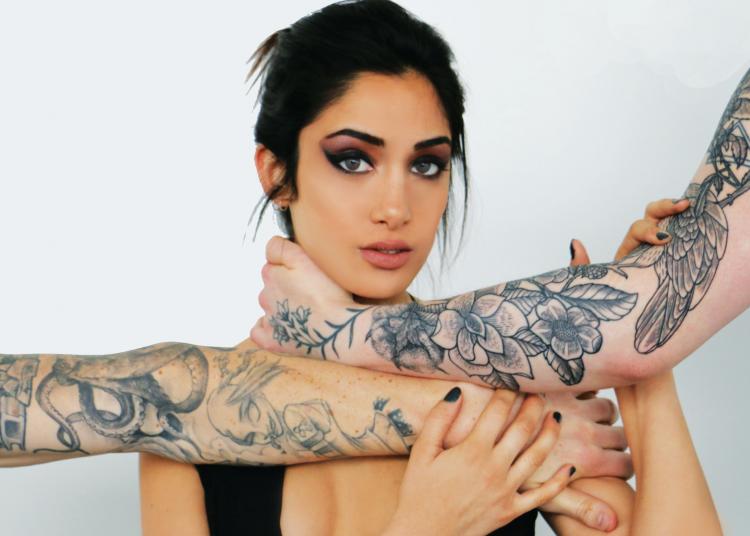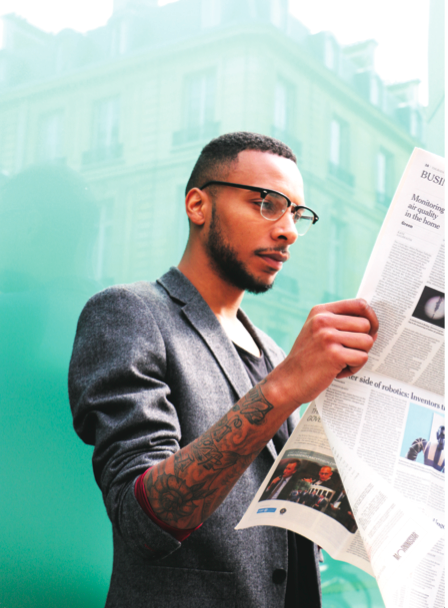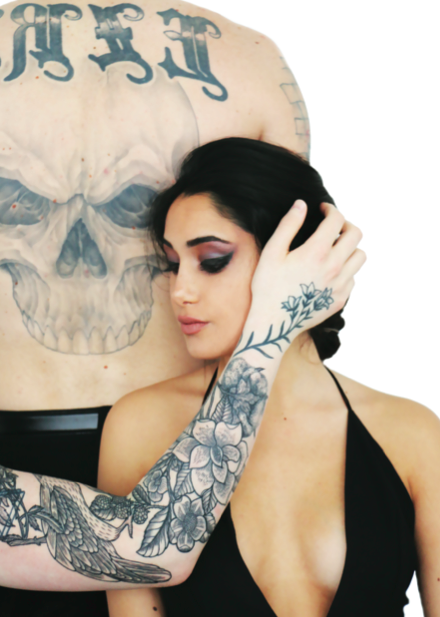The Changing Perception of Ink

The vast convention hall at La Villette is buzzing. It’s not the murmured buzz of human chatter, or the ambient buzz of commercial clatter. It’s a strangely unfamiliar buzzing sound—unless you’ve been tattooed.
On this early March weekend, the world’s top tattoo artists have gathered here in the Grande Halle de la Villette, a renovated abattoir on the northeastern edge of Paris. Nearly 350 tattooists are busy at their trade, sticking electric colored pens into the skin of clients who have flocked here from all parts of the globe for the Mondial du Tatouage gathering, attended by some 30,000 this year. Onlookers mill about among hundreds of stands, gawking at tattoo artists, pens buzzing, intensely focused on decorating skin with ink.
The Mondial du Tatouage founder is a household name: Tin Tin. Long considered the tattoo king in Paris, Tin Tin has worked on the skin of many celebrities in the three decades he’s been in the business. When major fashion magazines need “fake ink” applied to the skin of supermodels, they turn to Tin Tin. He regularly appears on television, giving sound bites on the changing culture of body art and evolving perception of tattoos.
Tin Tin started back in the days when tattoos were still emerging in the cultural mainstream, moving away from their negative stereotype as the trademark of leather-clad bikers and trashy hookers. “At first, the people who were showing off their tattoos were the rockers, the bandits,” Tin Tin said in a recent interview with Metro News. “But today we tattoo housewives and businessmen. The clientele has evolved more by the number of people we tattoo. We are reaching all classes of society.” As tattoos become increasingly commonplace in most Western societies – even considered normal -- the perception of tattooists has also changed. Tin Tin says he and his fellow tattooists are finally recognized for what they are –artists.
Paris has long been at the center of avant-garde movements – from the explosion of modern music and art a century ago to pantsuits for women in fashion. Fittingly, a major exhibition on the history of tattoos has arrived in the French capital. “Tattooists, Tattooed,” running at the Musée du quai Branly in the 7th arrondissement, is a long-overdue affirmation that tattoos are a museum-worthy cultural artifact and art form.
The “Tattooists, Tattooed” exhibition documents the cultural history of tattoos stretching back thousands of years to prehistoric man. We learn that tattoos didn’t always serve as creative body decor. One of the oldest known tattoos dates back 5,300 years to an individual known as Ötzi the Iceman, a mummified Copper Age man whose long-frozen body was discovered by hiking tourists nearly twenty-five years ago in the Alps between Austria and Italy. Ötzi had over 61 tattoos of lines, dots, and simple crosses on his body. The earliest tattoos, like Ötzi’s, we made by cutting into the body with sharp blades and rubbing the open wounds with charcoal. X-rays revealed that Ötzi had bone degeneration at the location of each of his markings, leading researchers to speculate that these early tattoos were used to heal arthritis. During the Middle Kingdom of Egypt, around 2,000 BC, tattoos on women and female statuettes symbolized fertility and sexuality. In Māori tribal culture in New Zealand, the “moko” -- a tattoo covering the face -- marked a rite of passage into adulthood and the ultimate affirmation of identity. A facial tattoo signified the wearer’s place in his or her family and specific tribe. If the facial pain was too much to bear while getting tattooed, the unfinished tattoo was a sign of cowardice. In other cultures, tattoos were used to punish. In ancient Greek and Japanese cultures, for example, the tattoo as indelible mark on the body of a criminal was in itself punishment. The Japanese tattooed different symbols on both the face and arms to mark where a serious crime was committed. The Greeks and Romans tattooed their slaves and mercenaries as a deterrent against desertion and escape. In the Middle Ages, crusaders recognized their dead in battle by a Jerusalem Cross tattoo. If a crusader died in battle, he would be assured a Christian burial thanks to the tattooed symbol.
The word “tattoo” originates from the Polynesian “tatau”, which means to tap a mark into the body. The English explorer, Captain James Cook, adopted this word when he landed in Tahiti in 1769 and saw heavily inked islanders -- or “tattooed savages”. The word “tattoo” was thus adopted into the English vocabulary, trumping older versions of the word, like “scarring,” “painting,” and “staining.” When Captain Cook and his crew returned to Britain, many of his seamen were sporting tattoos, giving birth to the association of sailors and tattoos. Over time, tattoos permeated European culture, and by the Victorian period even members of the upper classes were getting tattooed. Even Queen Victoria was rumored to have a tattoo showing a tiger fighting a python. While this claim is open to dispute, her eldest son and heir Edward VII had a tattoo of a Jerusalem Cross. In Japan, tattoo culture thrived for centuries though today is associated with the criminal underworld, especially with the infamous Yazuka gang. It wasn’t until the twentieth century that tattoos as “spectacle” entered Western cultures, largely due to the migration of traveling circus performers. Technology advances in the United States led to a “mass production” of tattoos. World War II is considered the “Golden Age” of tattooing, as soldiers and sailors got tattooed to mark their patriotism. With this fashion, the upper echelons of society began to disdain tattoos. Thus began the modern association of tattoos and the lower classes. Sailors who had tattoos of naked women visible were not allowed into the Navy; and women could not get a tattoo unless they were 21, married, and accompanied by their spouse, mainly to ensure that tattoo artist wouldn’t later face the wrath of an angry father or husband.
The "Tattooists, Tattooed" exhibit at the Musée du quai Branly.Today tattoos, heavily inspired by classic Japanese styles, are becoming respectable again. According to the “Tattooists, Tattooed” catalogue: “In urban societies and in the ‘Westernized’ lifestyle, [a tattoo’s] marginal character is fading and it is becoming a relatively common bodily ornament.” Whereas 50 years ago, tattoos were seen as markings belonging only to hardened sailors, veterans, and criminals, the stigmatization faded and tattoos evolved from “subculture” status when celebrities embraced tattoo culture. Popular TV shows – for example “Miami Ink” set in a South Beach tattoo shop and seen in 160 countries -- gave people an inside look into tattoo parlors and created a demand. With those television shows emerged celebrity tattoo artists, such as Miami Ink owner Ami James Kat von D and Megan Massacre. Soon the world’s most famous celebrities were showing off their tattoos – from pop singers Avril Lavigne, Amy Winehouse and Rihanna to actress Angelina Jolie and footballers David Beckham and Tim Howard. Theresa Vail was the first Miss America contestant to display her tattoos during the swimsuit competition in the 2014 pageant.
Today some 36 percent of Americans between age 18 and 26 are tattooed, according to the Pew Research Center. In France, about 20 percent of the population between age 25 and 34 sport a tattoo, according to an IFOP poll. Professor Nicholas Thomas, author of the book Body Art, says tattoos are now a part of young peoples’ culture because of a cultural shift towards taking ownership of one’s body and identity. “People have all sorts of surgical interventions, medical and cosmetic. It is even possible to change your gender. This means that we now see our body as something we have a responsibility to design and make. Even something as simple as a fitness routine or a tan indicates this attitude.”
As tattoos are going mainstream, especially among youth, it might be asked if it’s just a passing trend that will fizzle, leaving today’s youth with body ink —from finger tattoos to giant works of art climbing up their leg—that will never fade, dooming them as they grow older to a life of stigmatization and judgment. It’s a troubling paradox – wanting what’s “in” right now, and also wanting what’s necessary later. Young people want tattoos, yet they also want security—especially when it comes to the dreaded prospect of landing a job.
France is known for its rigid and conservative office culture: sharp business suits for men, pantsuits for women. Conformity is the rule. There isn’t much room for sartorial eccentricity. In this setting, visible tattoos make a job candidate the odd one out – an unspoken reason for rejection.
George Kazolias, a reporter and TV news producer for Paris-based news organization Agence Internationale d’Images de Télévision, believes tattoos will hamper young people in the professional domain. “If you have a visible tattoo, you’re not going to get on the TV plateau, a lot of people will be put off,” says Kazolias. “If you’re going to do interviews with ministers and presidents and you’ve got visible tattoos, I don’t think your editor is going to send you to do that interview, because that could upset people.”
Anne-Marie Picard, a French professor born in Normandy and teaching in living in Paris since 2002, also believes tattoos are a handicap for professional careers. “You never see philosophers, doctors, sociologists on the television in France who have tattoos,” says Picard. “Even the young people in these same careers: they don’t have tattoos. I have never seen anyone on television, speaking as an expert, who had tattoos.”
Picard recounted the disappointment of her French husband when her two stepdaughters decided to get tattooed. Picard was less disappointed by the decision, because her stepdaughters’ tattoos were delicately drawn “like art.” However, she cautions French youth about tattoos in interviews. In France, students facing interviews are constantly warned to hide any tattoos they may have on their necks, arms, or other visible areas.
Image credit: Sasha Sanchez
Philippe Eynaud, a professor of Economics at the Sorbonne, says he never sees tattoos at the office. "In my department there are no tattoos, because we don't hire people who have tattoos," he says. Eynaud, a father of three, is strictly against tattoos for his children, calling them “une bêtise” -- a dumb mistake.
Hank Goldenberg, a student from Philadelphia completing his bachelor’s degree Paris, is hoping to find a job in the city after he graduates. Behind a head of curls and a charismatic smile, this 20-year-old boasts a tattoo like many young people. His tattoo is hidden on his chest. It reads: Audentes Fortuna Juvat, which means “Fortune Favors the Bold.” He knows that inked motto, if visible, could be a big problem for many employers in France.
“I think there’s a line to be drawn between tattoos that are visible on the body and those that are not,” says Goldenberg. “The professional world is not always accepting of visible tattoos and the stigmas attached to them. There’s still a lot of pushback against the sort of person that gets a tattoo on their arms or legs that people can see more often.”
Stefan Kaufmann, a psychology student in Paris who has interned at psychology offices and landscaping companies in the city, agreed. “I always cover up during the interview,” said Kauffman. His most visible tattoos are two eyes he designed by himself, located on the aspiring artist’s forearms. “You’ve got to ease employers into it, because there’s definitely still a stigma attached.”
Image Credit: Sasha SanchezWhile boasting a visible tattoo is still risky business for many companies, especially in countries like France, some professions are embracing the tattoo trend. Isabel, a 50-year-old French doctor, was one of the attendees at the Mondial du Tatouage. She definitely stood out: a middle-aged woman with a short bob, glasses, and conservative button-up. One would not have placed her as a tattoo fan, never mind someone who would be tattooed herself. And yet she has tattoos. Under her pressed white blouse, a huge tree-of-life springing cherry blossoms covers her back. And a dragonfly is inked onto her right leg. If getting a tattoo is not eye-popping for a teenager, Isabel was a doctor in her late forties when she decided to adorn her body with tattoos. Both her tattoos are less than a year old.
At the Mondial du Tatouage convention, Isabel watched her 17-year-old daughter get a large colorful flower tattoo on her shoulder. Flowers are a good choice, she says, because they never go out of style. “I never thought about getting tattoos before,” says Isobel. “Before, it was a trend: people got tattoos of their zodiac signs, for example, and that never interested me. Now, it’s more of an art, with many different tattooists practicing their interesting techniques and unique styles. It’s like the body is a canvas.”
Isabel says her tattoos do not pose problems for her career as a doctor in France. “My patients and I joke about it,” she says. “This doesn’t affect my relationship with my patients…It’s completely more accepted now for professional careers. Karma, an amazing tattooist based in Paris, told me that among his clients he’s tattooed a surgeon, a policeman, and men in suits and ties.” Yet despite her observations on changing professional codes in France, when asked for her last name, Isobel refuses, nervous about scaring off future patients.
Marc Feustel, a Parisian photographer and blogger for one of the largest advertising companies in France, says tattoos are still stigmatized in traditional professions. “In certain circles, it isn’t acceptable, like in finance. People don’t walk around with neck tattoos. But I’m certain there are some people who work in finance who do have tattoos.” Feustel says the creative and dynamic career fields are more open to body art. “There are other circles where you could climb very high, for example in design, you’re working in a very high-powered environment and that would be totally acceptable, or in advertising, where people almost expect it. Even in other fields, these days, tattoos are less considered to be something marginal.”
Feustel, who does not have any tattoos himself, says he doesn’t judge Parisians with visible tattoos as they’ve become much more commonplace. He sometimes wonders what particular inked symbol or design could mean, and why it was so significant for that person to want to mark in into their bodies forever. “In the past, tattoos were associated with a certain kind of person, who wanted to rebel against society in a general way,” he says. “Nowadays, people use tattoos for all different kinds of reasons. They use tattoos for commemorating an event, they use tattoos, in the case of breast cancer patients who have had a mastectomy, as a way of marking that moment, and people use tattoos for decorations, although I don’t know how much they think about them. In some cultures it’s almost a necessity. For professional football, almost everybody has tattoos, and if you don’t, you’re almost an outlier.”
Agathe Bouquet, an intern studying cuisine at Spontini 50, an exclusive restaurant in the 2ème arrondissement of Paris, says the cooking profession is open to tattoos. In part, she says, it’s because cuisine is an artistic field. More importantly, in high-class restaurants like Spontini 50 the chefs are out of sight in the kitchen, far from the potentially disapproving regards of diners. Pierre Morange, a student interning as a marketing and events representative at wine and champagne company Jéroboam, says tattoos are not a problem in his future profession. “You’re looking for a good bottle of wine, and you’re not going to care if the expert who sells it to you has tattoos,” says Morange. “Also, my career isn’t on Wall Street. The atmosphere of my job is less formal.”
Some young professionals in Paris have an even more open and pro-active attitude to tattoo culture. Brent Ramsey is a fashion journalist working and finishing a master’s degree in Paris. He currently copy edits and writes for Eclectic Magazine, a fashion and culture publication based in Paris, and also writes for several fashion publications in Asia. Ramsey’s most visible tattoos cover his entire right arm and part of his hand with stark black ink. Flowers, birds, blackberries and vines make up Ramsey’s growing tattoo sleeve.
“I don’t think tattoos are an issue in the fashion world at all—in fact, you could say they’re the new trend, the new fashion accessory,” said Ramsey. Ramsey agrees that tattoos are still not embraced with open arms by everyone in Paris, but pose no problem for his career in fashion journalism in Paris, the world’s historically avant-garde city. “I was at the L’Oréal headquarters the other day, and the director of human resources complemented me on my tattoos as he walked by.”
Alexandre Fredy, a 23-year-old optician, has a tattoo-centric business that he thinks will take off. “I’m going to design school next year so I can open my own eyeglasses shop,” he says. “Tattoos will be openly shown, to attract the ‘hipster’ and cool vibe I’m going for. Ideally, I’d like to have an eyeglasses shop that’s two floors, with the second floor being a tattoo parlor. That’s the dream.” For now, however, he’ll have to endure working with tucked-away tattoos. Fredy has a large, finely sketched deer whose antlers sprawl up his right arm to meet another drawing of a swimming whale. He wears long sleeves every day to hide the designs. “When I’m the big boss, I will show my tattoos,” he says.









